#image expert india
Explore tagged Tumblr posts
Text
Analyzing social media data has become increasingly crucial for gaining insights into user behavior, market trends, and overall public sentiment. Advanced techniques in social media data analysis involve utilizing sophisticated tools and methodologies to extract meaningful information.
#Social Media Analytics#Online Reputation Management India#India ORM Services#ORM Solutions India#Best ORM Company India#Online Brand Protection India#Reputation Repair India#India Reputation Monitoring#India Reputation Cleanup#Personal Brand Management India#Online Image Repair India#Corporate Reputation India#India ORM Strategies#ORM for Small Businesses India#India Reputation Crisis#Affordable ORM Services India#ORM Expert India#India Online Image Management#Local Business Reputation India#ORM for Startups India#India Reputation Building
0 notes
Text

🚀 Superfast Cut-Out Images and Background Removal 🌟
Experience the lightning-fast solution to cut-out images and remove backgrounds for your photos! We understand that time is of the essence, and that's why we offer a superfast service that doesn't compromise on quality.
Why Choose Us?
⚡ Rapid Turnaround: We take pride in delivering results at warp speed, ensuring that your project is completed in record time.
✔️ Precision and Quality: Speed doesn't mean sacrificing quality. Our expert team maintains the highest standards to make your images stand out.
💬 Clear Communication: We streamline the process, making it quick and easy for you to submit your images and get the results you need.
💯 Client Satisfaction: Your happiness is our priority, and we guarantee your satisfaction with every project.
💰 Competitive Pricing: Enjoy swift, professional services at rates that won't break the bank.
Our Services:
✂️ Background Removal: We'll cleanly cut out backgrounds, giving you the freedom to add your desired setting or leave it transparent.
🌈 Image Enhancement: We ensure your subject looks its best, enhancing colors, sharpness, and overall quality.
🖼️ Customized Solutions: No two projects are the same. We cater to your specific needs, offering tailored results.
Get Started: Ready to experience the superfast difference? Contact us today, share your project details, and watch your images transformed in no time. We're here to meet your deadlines and exceed your expectations.
🌠 Speed Meets Quality: Don't wait when you need to make your images pop. Contact us now and let's create a visual impact like never before!
Customize this description to reflect your specific services and unique selling points. The key is to highlight the speed and quality of your cut-out image and background removal services while assuring potential clients of your commitment to delivering top-notch results.
Get Started
#clipping path#clipping path in illustrator#css clipping path#how to make a clipping path in illustrator#clipping path service#make clipping path illustrator#svg clipping path#clipping path in photoshop#clipping path services provider#create clipping path indesign#indesign clipping path#clipping path service providers#clipping path india#how to create a clipping path in illustrator#clipping path adobe illustrator#what is clipping path#clipping path company#image clipping path service#best clipping path service#clipping path expert#clipping path companies#asian clipping path#how to make a clipping path in photoshop#photo clipping path#create clipping path photoshop#how to create clipping path in photoshop#offshore clipping path#clipping path service provider company#clipping path picture#how to create a clipping path in photoshop
0 notes
Text
Indian Prime Minister Narendra Modi is, by some measures, the most popular leader in the world. Prior to the 2024 election, his Bharatiya Janata Party (BJP) held an outright majority in the Lok Sabha (India’s Parliament) — one that was widely projected to grow after the vote count. The party regularly boasted that it would win 400 Lok Sabha seats, easily enough to amend India’s constitution along the party's preferred Hindu nationalist lines.
But when the results were announced on Tuesday, the BJP held just 240 seats. They not only underperformed expectations, they actually lost their parliamentary majority. While Modi will remain prime minister, he will do so at the helm of a coalition government — meaning that he will depend on other parties to stay in office, making it harder to continue his ongoing assault on Indian democracy.
So what happened? Why did Indian voters deal a devastating blow to a prime minister who, by all measures, they mostly seem to like?
India is a massive country — the most populous in the world — and one of the most diverse, making its internal politics exceedingly complicated. A definitive assessment of the election would require granular data on voter breakdown across caste, class, linguistic, religious, age, and gender divides. At present, those numbers don’t exist in sufficient detail.
But after looking at the information that is available and speaking with several leading experts on Indian politics, there are at least three conclusions that I’m comfortable drawing.
First, voters punished Modi for putting his Hindu nationalist agenda ahead of fixing India’s unequal economy. Second, Indian voters had some real concerns about the decline of liberal democracy under BJP rule. Third, the opposition parties waged a smart campaign that took advantage of Modi’s vulnerabilities on the economy and democracy.
Understanding these factors isn’t just important for Indians. The country’s election has some universal lessons for how to beat a would-be authoritarian — ones that Americans especially might want to heed heading into its election in November.
-via Vox, June 7, 2024. Article continues below.
A new (and unequal) economy
Modi’s biggest and most surprising losses came in India’s two most populous states: Uttar Pradesh in the north and Maharashtra in the west. Both states had previously been BJP strongholds — places where the party’s core tactic of pitting the Hindu majority against the Muslim minority had seemingly cemented Hindu support for Modi and his allies.
One prominent Indian analyst, Yogendra Yadav, saw the cracks in advance. Swimming against the tide of Indian media, he correctly predicted that the BJP would fall short of a governing majority.
Traveling through the country, but especially rural Uttar Pradesh, he prophesied “the return of normal politics”: that Indian voters were no longer held spellbound by Modi’s charismatic nationalist appeals and were instead starting to worry about the way politics was affecting their lives.
Yadav’s conclusions derived in no small part from hearing voters’ concerns about the economy. The issue wasn’t GDP growth — India’s is the fastest-growing economy in the world — but rather the distribution of growth’s fruits. While some of Modi’s top allies struck it rich, many ordinary Indians suffered. Nearly half of all Indians between 20 and 24 are unemployed; Indian farmers have repeatedly protested Modi policies that they felt hurt their livelihoods.
“Everyone was talking about price rise, unemployment, the state of public services, the plight of farmers, [and] the struggles of labor,” Yadav wrote...
“We know for sure that Modi’s strongman image and brassy self-confidence were not as popular with voters as the BJP assumed,” says Sadanand Dhume, a senior fellow at the American Enterprise Institute who studies India.
The lesson here isn’t that the pocketbook concerns trump identity-based appeals everywhere; recent evidence in wealthier democracies suggests the opposite is true. Rather, it’s that even entrenched reputations of populist leaders are not unshakeable. When they make errors, even some time ago, it’s possible to get voters to remember these mistakes and prioritize them over whatever culture war the populist is peddling at the moment.
Liberalism strikes back
The Indian constitution is a liberal document: It guarantees equality of all citizens and enshrines measures designed to enshrine said equality into law. The signature goal of Modi’s time in power has been to rip this liberal edifice down and replace it with a Hindu nationalist model that pushes non-Hindus to the social margins. In pursuit of this agenda, the BJP has concentrated power in Modi’s hands and undermined key pillars of Indian democracy (like a free press and independent judiciary).
Prior to the election, there was a sense that Indian voters either didn’t much care about the assault on liberal democracy or mostly agreed with it. But the BJP’s surprising underperformance suggests otherwise.
The Hindu, a leading Indian newspaper, published an essential post-election data analysis breaking down what we know about the results. One of the more striking findings is that the opposition parties surged in parliamentary seats reserved for members of “scheduled castes” — the legal term for Dalits, the lowest caste grouping in the Hindu hierarchy.
Caste has long been an essential cleavage in Indian politics, with Dalits typically favoring the left-wing Congress party over the BJP (long seen as an upper-caste party). Under Modi, the BJP had seemingly tamped down on the salience of class by elevating all Hindus — including Dalits — over Muslims. Yet now it’s looking like Dalits were flocking back to Congress and its allies. Why?
According to experts, Dalit voters feared the consequences of a BJP landslide. If Modi’s party achieved its 400-seat target, they’d have more than enough votes to amend India’s constitution. Since the constitution contains several protections designed to promote Dalit equality — including a first-in-the-world affirmative action system — that seemed like a serious threat to the community. It seems, at least based on preliminary data, that they voted accordingly.
The Dalit vote is but one example of the ways in which Modi’s brazen willingness to assail Indian institutions likely alienated voters.
Uttar Pradesh (UP), India’s largest and most electorally important state, was the site of a major BJP anti-Muslim campaign. It unofficially kicked off its campaign in the UP city of Ayodhya earlier this year, during a ceremony celebrating one of Modi’s crowning achievements: the construction of a Hindu temple on the site of a former mosque that had been torn down by Hindu nationalists in 1992.
Yet not only did the BJP lose UP, it specifically lost the constituency — the city of Faizabad — in which the Ayodhya temple is located. It’s as direct an electoral rebuke to BJP ideology as one can imagine.
In Maharashtra, the second largest state, the BJP made a tactical alliance with a local politician, Ajit Pawar, facing serious corruption charges. Voters seemingly punished Modi’s party for turning a blind eye to Pawar’s offenses against the public trust. Across the country, Muslim voters turned out for the opposition to defend their rights against Modi’s attacks.
The global lesson here is clear: Even popular authoritarians can overreach.
By turning “400 seats” into a campaign slogan, an all-but-open signal that he intended to remake the Indian state in his illiberal image, Modi practically rang an alarm bell for constituencies worried about the consequences. So they turned out to stop him en masse.
The BJP’s electoral underperformance is, in no small part, the direct result of their leader’s zealotry going too far.
Return of the Gandhis?
Of course, Modi’s mistakes might not have mattered had his rivals failed to capitalize. The Indian opposition, however, was far more effective than most observers anticipated.
Perhaps most importantly, the many opposition parties coordinated with each other. Forming a united bloc called INDIA (Indian National Developmental Inclusive Alliance), they worked to make sure they weren’t stealing votes from each other in critical constituencies, positioning INDIA coalition candidates to win straight fights against BJP rivals.
The leading party in the opposition bloc — Congress — was also more put together than people thought. Its most prominent leader, Rahul Gandhi, was widely dismissed as a dilettante nepo baby: a pale imitation of his father Rajiv and grandmother Indira, both former Congress prime ministers. Now his critics are rethinking things.
“I owe Rahul Gandhi an apology because I seriously underestimated him,” says Manjari Miller, a senior fellow at the Council on Foreign Relations.
Miller singled out Gandhi’s yatras (marches) across India as a particularly canny tactic. These physically grueling voyages across the length and breadth of India showed that he wasn’t just a privileged son of Indian political royalty, but a politician willing to take risks and meet ordinary Indians where they were. During the yatras, he would meet directly with voters from marginalized groups and rail against Modi’s politics of hate.
“The persona he’s developed — as somebody kind, caring, inclusive, [and] resolute in the face of bullying — has really worked and captured the imagination of younger India,” says Suryanarayan. “If you’ve spent any time on Instagram Reels, [you’ll see] an entire generation now waking up to Rahul Gandhi’s very appealing videos.”
This, too, has a lesson for the rest of the world: Tactical innovation from the opposition matters even in an unfair electoral context.
There is no doubt that, in the past 10 years, the BJP stacked the political deck against its opponents. They consolidated control over large chunks of the national media, changed campaign finance law to favor themselves, suborned the famously independent Indian Electoral Commission, and even intimidated the Supreme Court into letting them get away with it.
The opposition, though, managed to find ways to compete even under unfair circumstances. Strategic coordination between them helped consolidate resources and ameliorate the BJP cash advantage. Direct voter outreach like the yatra helped circumvent BJP dominance in the national media.
To be clear, the opposition still did not win a majority. Modi will have a third term in office, likely thanks in large part to the ways he rigged the system in his favor.
Yet there is no doubt that the opposition deserves to celebrate. Modi’s power has been constrained and the myth of his invincibility wounded, perhaps mortally. Indian voters, like those in Brazil and Poland before them, have dealt a major blow to their homegrown authoritarian faction.
And that is something worth celebrating.
-via Vox, June 7, 2024.
#india#narendra modi#pm modi#modi#bjp#lok sabha elections#rahul gandhi#democracy#2024 elections#authoritarianism#anti authoritarian#good news#hope
743 notes
·
View notes
Text
To improve his political communication, Modi was one of the first Indian politicians to use the services of a U.S. public relations firm, APCO Worldwide, which he hired in 2007. This company—which had already worked for Nigeria’s former dictator (Sani Abacha), the president for life of Kazakhstan (Nursultan Nazarbaiev), and the Russian oligarch Mikhail Khodorkovsky—was then grooming Modi’s image for a monthly fee of $25,000.82 The contract binding the government of Gujarat and APCO Worldwide (which already handled the promotion of Vibrant Gujarat, an economic fair that will be discussed in greater detail further on) was renegotiated in 2010 so as to identify journalists who could be media ambassadors for Gujarat, in connection with the Friends of Gujarat association of Gujaratis living in the United States and the United Kingdom. Modi has also surrounded himself with political communication consultants, such as Prashant Kishor, a U.S.-educated Bihari who joined his staff in 2012 at the age of thirty-five and who quickly established himself as a close advisor. Such an entourage illustrates Modi’s ability to rely on a team of communications experts who do not necessarily have affinities with Hindu nationalism.
In addition, Modi hired an army of young supporters to flood social media with messages, for as Sunil Khilnani writes, “the real masterminds of Modi’s political campaigns are not shadowy figures wearing RSS uniform under their plainclothes. They are smart, cheery IIT-ians [alumni of Indian Institutes of Technology]: men like Rajesh Jain.”87 This young man in fact represents the typical profile of these digital propaganda experts. With an engineering degree from Columbia University, Jain was not only active on social media; he also founded a company, IndiaWorld Web, soon renamed Netcore, which became a pillar of Modi’s propaganda. On social media, Modi supporters have been tasked with countering criticism against him, and they often resort to particularly aggressive methods to do so.
Modi's India (2021), Christophe Jaffrelot
63 notes
·
View notes
Text
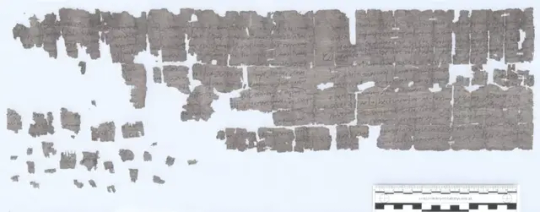
Archaeologists Find Roman Centurions' Letters in Ancient Animal Cemetery in Egypt
Discovered among the graves of hundreds of cats, dogs and monkeys, the correspondence was likely written by centurions in the first century.
An ancient pet cemetery in Egypt is becoming a gold mine for rare Roman history. Alongside its carefully constructed graves of more than 200 beloved cats, dogs and monkeys, archaeologists have now found letters handwritten 1,900 years ago by Roman centurions stationed nearby.
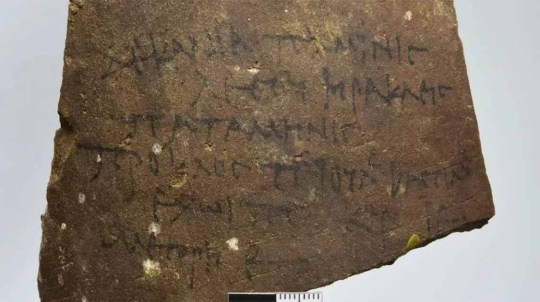
Though Rome controlled Egypt for centuries—from the year 30 to the mid-600s—few Roman sites still exist in the region, lead researcher Marta Osypińska, an archaeologist at Poland’s University of Wrocław’s Institute of Archaeology, tells Science in Poland’s Ewelina Krajczyńska. The burial ground, which dates back to the first and second centuries, is located in Berenike, a Red Sea port in southern Egypt built by Roman Emperor Tiberius.
Osypińska’s team first discovered the cemetery in 2011, and they’ve been slowly excavating it since then. Among the burials of cats, dogs and exotic monkeys, researchers have found ceramics, Roman coins and now, several letters written on papyrus by military officers who commanded units of Roman legions.

According to a statement by the University of Wrocław, these “priceless sources of knowledge about the ancient inhabitants of Berenike” are from the era of Emperor Nero, a cruel Roman ruler of the mid-first century. During his reign, Berenike was a hub of cross-continental trade, through which goods from India, Arabia and East Africa flowed, Osypińska says in the statement. The port was home to regional merchants, Roman higher-ups in charge of trading and—as historians have long suspected but never before proven—a unit of the Roman military.
The newly-found correspondence contains several names of presumed Roman centurions: Haosus, Lucinius and Petronius. In one letter, Petronius asks Lucinius, who is stationed in Berenike, about the prices of some exclusive goods, Osypińska tells Science in Poland. Petronius writes that he’s sending money via “dromedarius,” a unit of Roman soldiers traveling on camels, and tells Lucinius to provide the soldiers with veal and tentpoles.
Researchers believe ancient Romans likely kept the papyri in a nearby office which was later destroyed, accidentally distributing its contents over the pet cemetery, as McClatchy’s Aspen Pflughoeft writes. Excavators found the papyrus in rolled fragments, which they showed to Rodney Asta, an expert of ancient inscriptions, who pieced together a page approximately one and a half feet long and a foot wide, Osypińska tells Science in Poland. Among the animal graves, researchers have found countless ostracons—pieces of pottery etched with writing—but the papyri are the first paper texts to be found on-site.
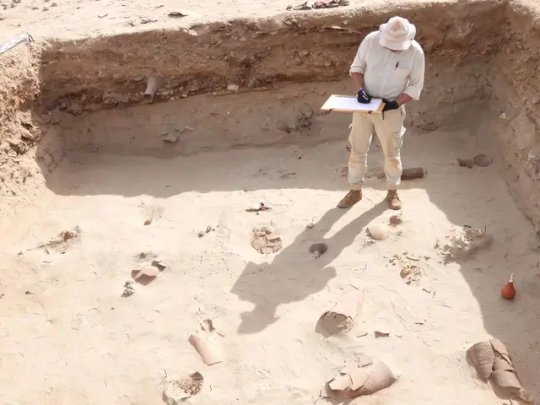
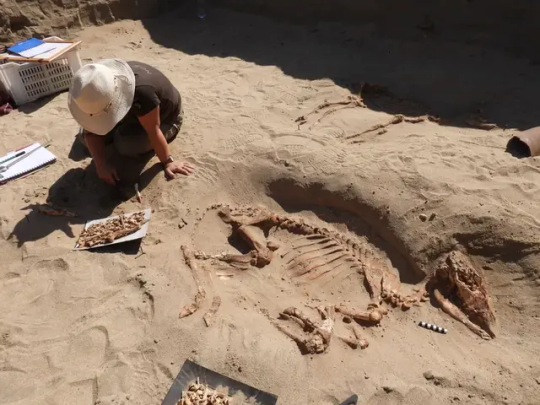

The letters are the latest evidence of advanced Roman trade to be found in the cemetery, per the statement: The skeletons of several buried monkeys, recently identified as macaques native to India, show that Romans imported non-utilitarian animals across oceans. These primates, along with long-haired cats and miniature dogs, were “elite pets,” and many were buried with toys, ceramics or other animal companions.
As Osypińska notes in the statement, it may seem difficult to reconcile the image of commanders of an ancient foreign legion with such animals, which were “treated as family members.”
“However, our findings unequivocally show that the military elite surrounded themselves with elite pets and led an exclusive lifestyle,” she adds.
By Sonja Anderson.

#Archaeologists Find Roman Centurions' Letters in Ancient Animal Cemetery in Egypt#Berenike#ancient pet cemetery in Egypt#Roman Emperor Tiberius#ancient artifacts#archeology#archeolgst#history#history news#ancient history#ancient culture#ancient civilizations#roman history#roman empire
74 notes
·
View notes
Text
updated! ID by @swosheep

ID 1: all images are screenshots of an Instagram post by letstalkpalestine. The first is a title slide and reads "lets talk: Why does israel colonize Palestine? Explaining Zionism and Settler Colonialism".

ID 2: the second image reads: "What is misleadingly termed by israel and its Western allies the "israeli-Palestinian conflict" is a single, long-running process of the Zionist colonization of Palestine. This understanding is not new, and was in fact first understood by early Zionist leaders themselves, but has only recently been accepted by Western historians. To understand why the Gaza Genocide and everything else is happening, we need to understand Zionism and why experts consider it a form of settler colonialism."
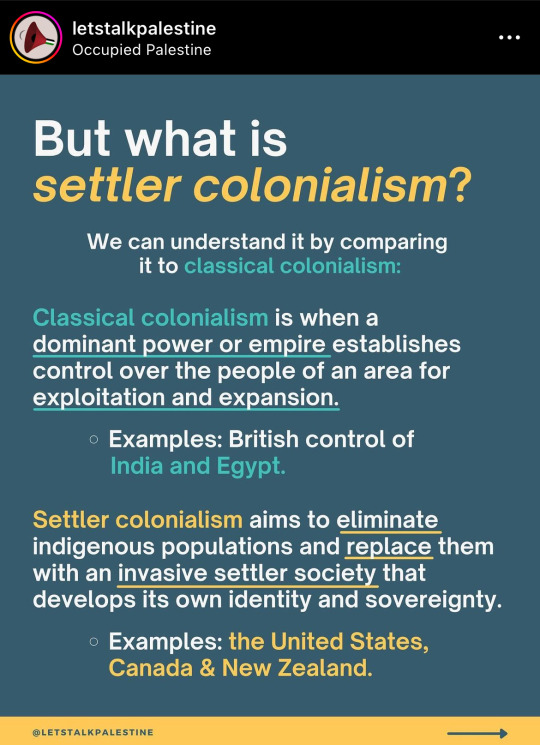
ID 3: the third image is titled: "But what is settler colonialism?" The body text reads: "We can understand it by comparing it to classical colonialism: Classical colonialism is when a dominant power or empire establishes control over the people of an area for exploitation and expansion. Examples: British control of India and Egypt. Settler colonialism aims to eliminate indigenous populations and replace them with an invasive settler society that develops its own identity and sovereignty. Examples: the United States, Canada & New Zealand."

ID 4: the fourth image is titled: "Settler colonialism is different from classical colonialism in 3 main ways:". There is a table comparing the ways. One column of the table is titled: "Settler colonialism" and the 3 points are: "1. Only temporarily & initially relies on the empire for support. 2. Motivated by desire to take over land. 3. Treats new land as a permanent national homeland for settlers." The second column of the table is titled: "Classical colonialism" and the 3 points are: "1. Always dependent on mother empire. 2. Motivated by exploiting natural resources. 3. Uses new land and its resources to serve the empire."
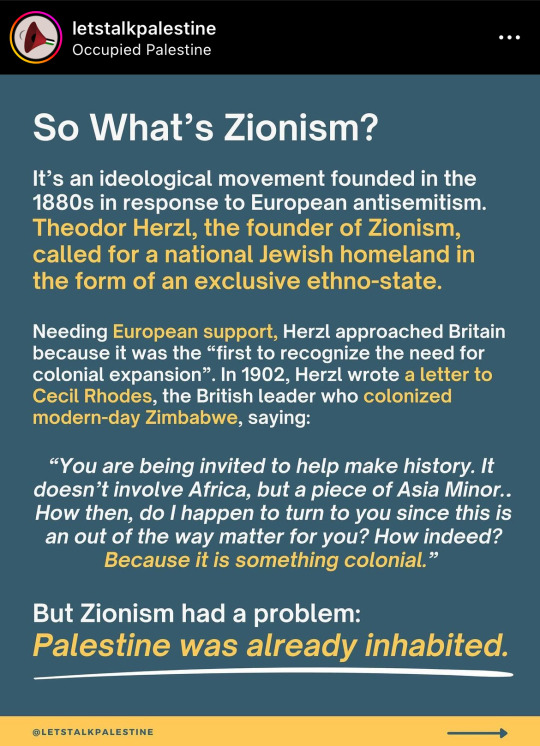
ID 5: the fifth image is titled: "So What's Zionism?". The body text reads: "It's an ideological movement founded in the 1880s in response to European antisemitism. Theodor Herzl, the founder of Zionism, called for a national Jewish homeland in the form of an exclusive ethno-state. Needing European support, Herzl approached Britain because it was the "first to recognize the need for colonial expansion". In 1902, Herzl wrote a letter to Cecil Rhodes, the British leader who colonized modern-day Zimbabwe, saying: 'You are being invited to help make history. It doesn't involve Africa, but a piece of Asia Minor.. How then, do I happen to turn to you since this is an out of the way matter for you? How indeed? Because it is something colonial.' But Zionism had a problem: Palestine was already inhabited."

ID 6: The sixth image is titled: "Zionism & Palestinians". The body text reads: "To establish a Jewish state (israel) in Palestine, Jewish people had to constitute the majority of the population. [quote] 'Only a state with at least 80% Jews is a viable and stable state.' [unquote] -[a quote from] Ben-Gurion, Israel's first Prime Minister. But Palestinians were the majority at the time. For Zionism to succeed, non-Jewish people had to be removed from Palestine and, in turn, Jewish settlers had to take their place. [quote] 'We must expel the Arabs and take their place' [unquote] -[a quote from] Ben-Gurion, Israel's first Prime Minister. This was implemented, and in 1947-1949, Zionist militias conducted a mass campaign of ethnic cleansing against Palestinians - the Nakba. 80% of Palestinians in the heartland were expelled to create Israel's Jewish majority."

ID 7: The seventh image is titled: "1. Initial & temporary reliance on the empire". The body text reads: "To colonize Palestine, Zionist leaders knew they needed the support of an empire. Zionists secured British support with the 1917 Balfour Declaration. This alliance protected the project from Arab opponents, facilitated mass settlement, provided state lands & allowed the creation of Zionist militias. But during World War II, Zionist attempts to accelerate the process of statehood clashed with British interests. Zionist militias began carrying out attacks against the British and, in 1948, Britain withdrew from Palestine. Like European settlers who revolted against Britain in the American Revolution to establish their own independent settler colonial state, Zionists also revolted against Britain to establish their own settler colonial state."

ID 8: The eighth image is titled: "2. Desire to take over land & eliminate the native population". The body text reads: "The Zionist movement aims for as much Palestinian land as possible with as few Palestinians as possible. Zionism inherently opposes Palestinian freedom, because its vision of 'Jewish self-determination' needs the exclusion of non-Jewish people. Since nobody would willingly accept exclusion from their own land, Zionism needs the violent persecution and elimination of the existing population in order to fully succeed. [quote] 'If I wish to substitute a new building for an old one, I must demolish before I construct.' [unquote] - [a quote from] Theodor Herzl, founder of Zionism".

ID 9: The ninth image is titled: "3. Permanent homeland". The body text reads: "Zionism's goal wasn't to establish a temporary base for an empire but a permanent homeland for a new settler population. To create a new society in a populated country, Zionists claimed Palestine by moral & divine right, an example of the 'Logic of Elimination'. A pillar of settler colonialism, the 'Logic of Elimination' is when settlers develop moral justifications to eliminate the native population. Zionist talking points like - 'Palestine doesn't exist'; - 'israel made the desert bloom'; - 'israel is technologically advanced'; are used to justify the elimination of Palestinians. Such points were used in other cases of settler colonialism like South Africa, with the 'Empty Land' myth arguing that Black people arrived in South Africa at the same time as white settlers."

ID 10: The tenth image is titled: "Zionism Today". The body text reads: "A Jewish state was created, but the Zionist project isn't fully realized - Palestinians remain & resist, asserting a threatening national identity. In response, israel has doubled down on its attempts to eliminate the Palestinian people while colonizing more land. Home demolitions, ethnic cleansing, segregated settlements, erasing culture, and apartheid are methods of the Logic of Elimination rooted in Zionism as a settler colonial movement. 'But Zionism is just Jewish self-determination.' All settler colonial movements aim to advance the settlers' 'self-determination' by eliminating the natives. It's never justified. Palestinians are resisting the most aggressive ongoing settler colonial project in the world. Freedom, justice & equality are impossible without dismantling Zionism, a form of: Settler Colonialism."
#reaux speaks#zionism#free palestine#free gaza#gaza#genocide#palestine#settler colonialism#great britain#history#ethnostate#ethnic cleansing#anti zionism#resources#instagram
195 notes
·
View notes
Text
On a chilly spring morning in March, British coast guards spotted something unusual around 100 kilometers off the Scottish shoreline: a dark stain, stretching 23 kilometers into the North Atlantic Ocean.
According to an internal analysis prepared by the coast guard’s satellite services and seen by POLITICO, the likely source of that stain was Innova, a tanker roughly the size of the Eiffel Tower that at the time was hauling 1 million barrels of sanctioned oil from Russia on its way to a refinery in India.
Yet the coast guard did little to investigate further, and the tanker — free from any repercussion — continues to trade oil today, helping fill the Kremlin’s war chest more than two years into its full-scale invasion of Ukraine.
The Innova is just one of hundreds in the world’s so-called shadow fleet, a collection of often aging, poorly maintained ships sailing in defiance of Western sanctions — and spreading environmental harm without consequences.
A joint investigation by POLITICO and the not-for-profit journalism group SourceMaterial found at least nine instances of covert shadow fleet vessels leaving spills in the world’s waters since 2021, using satellite images from the SkyTruth NGO paired with shipping data from market analysis firm Lloyd’s List and commodity platform Kpler.
Swedish Foreign Minister Maria Malmer Stenergard told POLITICO the ships posed a “significant danger” to the marine environment. “The incidents [here] illustrate this.”
It’s a problem that’s only grown worse following Russian President Vladimir Putin’s full-scale invasion of Ukraine. With Moscow under Western sanctions, an increasing number of tankers are ferrying illicit goods — and potential environmental devastation — across the globe. Not only are these vessels creaky and largely unregulated, they’re often uninsured, meaning that in case of a leak, or more serious spill, a government would struggle to hold them accountable.
POLITICO and SourceMaterial identified discharges everywhere from Thailand to Vietnam to Italy and Mexico, all linked to the shadow fleet. The tankers also passed through busy shipping corridors like the Red Sea and the Panama Canal, meaning any serious accident could rupture international trade routes.
Experts believe it’s only a matter of time before one of these ships suffers a catastrophe with major environmental — and economic — devastation.
“The oil spills and risk of slicks are horrendous,” said Isaac Levi, Europe-Russia lead and a shadow fleet expert at the Centre for Research on Energy and Clean Air (CREA), a think tank. “Beyond the environmental damage, some of which will be irreversible, it’s a huge impact to coastal states that have to bear the cost of cleaning this up.”
In short: “It’s a ticking time bomb,” Levi said.
12 notes
·
View notes
Text
''Humanities are unnecesary and a burden in modern society!'' is a statement that will never be valid, at least not as long as we get takes as moronic as this one.

Losing my mind at this guy. Literally a google search away. They do not even try to hide it. And most people who see this, according to the numbers in the tweet, do agree!
But it gets worse.
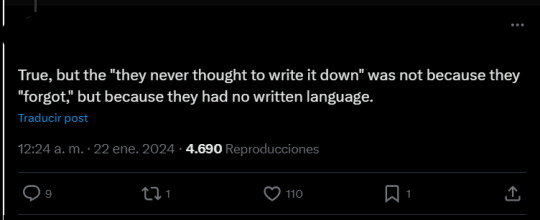
Those dumb guys in the primitive americas did not know how to write. Wait, what? What's this?
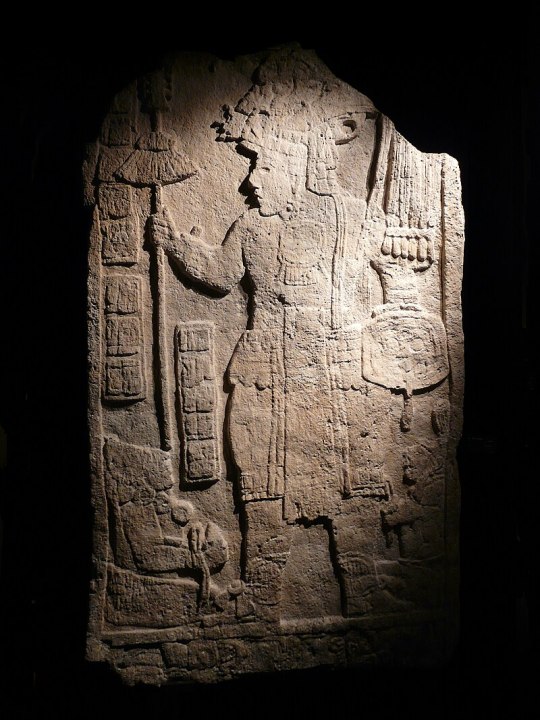
Wait, what? A mayan king commemorating an HISTORICAL battle by using WRITTEN GLYPHS? B-but they have no sense of time or writting! That must be a fluke!
Mmmh? But...?
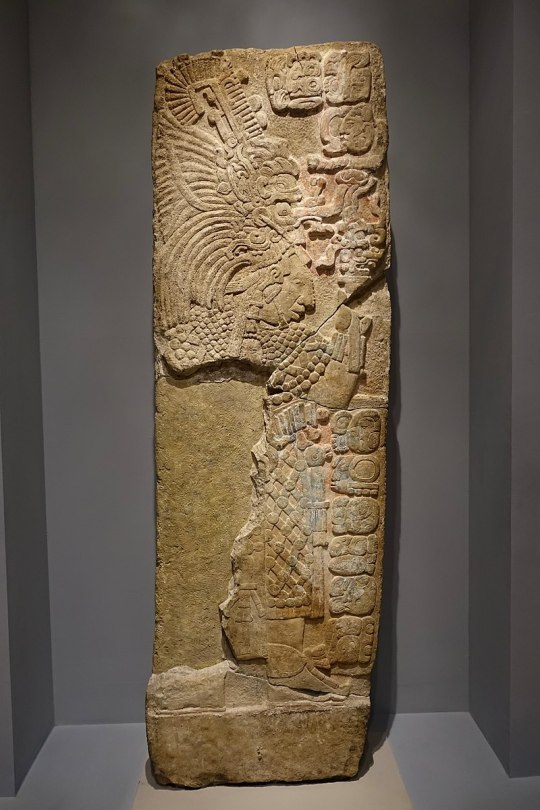
A stel portraying a maya queen, with again written symbols mentioning her directly?
''No, those don't count, they're just dumb short phrases, they are surely uncapable of writting down coherent tex-''

Wow, the Dresden Codex, dated from 11th century (mayans were not even at their peak here) writting down their religion, customs, different gods and even complex astronomical movements all-in-one!
Those stone age troglodytes were surely lucky to be able to keep time counts in the thousands of years!

Okay, you're right. Mentioning mayans is cheating because they do not use enough ''actual words'' only drawn ones!

Forget the fact they had a whole ass syllabic system, that experts have been deciphering for decades.
By this rule of thumb, the japanese are all illiterate because they do not actually use words, but abstractions in the form of syllabes. Maya greatest mistake was to do their particles too artistically or something.
The previous tweet implied there was going to be a threat debunking whatever rambling that person was on about, but it stopped there. So... okay.
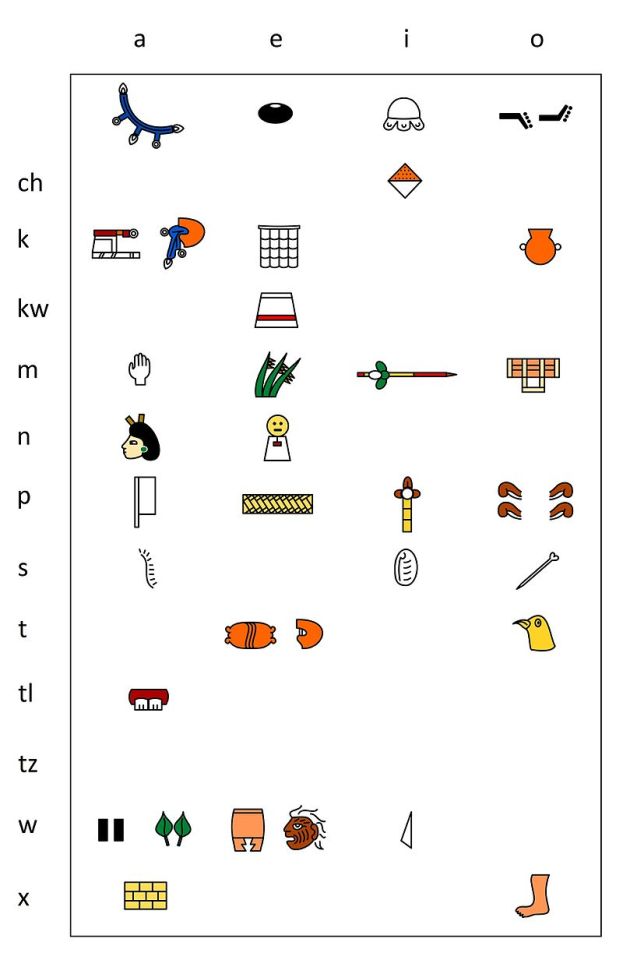
Regarding the aztecs, that would actually be somewhat accurate. They relied mostly on ideographic writting, but they also combined syllabes. They were still developing their language independently of the mayans. The process was interrupted by the arrival of the spanish crown.
However the writting of the aztecs is stupid and primitive because it doesnt resemble my latin alphabet enough AAAAGH! With such underdeveloped writting they wouldn't be able to write texts, let alone make librar-

Someone else answered, and it's literally the first google result right now, putting this curious image.
I wonder what it's trying to convey.

Solved. It's not a library because... well it's not! It's made of stone and has stupid scribblings stored. It's a nu-library!

How are we going to tell Asurbanipal his assyrian library does not count because it's just not a library, because we need to dunk on the americas?

Forget the books. The real reason they're regressive is because they had no wheel.

They obviously relegated the wheel to toys, because after inventing, polishing it, even using it metaphorically in their intrincate calendars, they decided they didn't know how to use it beyond children toys. It was, again, a skill issue.
Regarding armor and weapons, did you know spanish conquistadores discarded their plate mails and used cotton armor from the natives, far better resistant to rust, and able to disperse slashing and piercing damage with comparable success? Far more comfortable, mobile, and less prone to well, cooking you alive.
How come, also, that Mayas and Aztecs knew each other? They lived in different zones of Mexico with frontiers separated by kilometers? Their trading routes (shared) must have been a stroke of dumb luck.

Apparently if you don't cross the whole ass Pacific/Atlantic Ocean, it does not count. By the way, did anyone in China, India, Africa, Europe or even Australia know about the Native Americans?
Conclussion: If you exclude Mayans, Aztecs, a myriad of other cultures in the Americas, their issolation to the rest of the continents, their set of beliefs, languages, structures, trade routes, traditions, libraries and use of the wheel among some other ''tiny'' advancements... well, you're right. They end being quite primitive.
I guess that's their fault. Maybe they should have conquered us first or some crap.

Those morons and their obscure scribblings.
PD: I excluded this person name in purpose. Do not send harassment to them. This generalized ignorance of America cultures does not radiate from a single person, instead is a shared set of common beliefs. We must combat the biased takes in constructive ways.
#language#culture#rant#anthropology#history#linguistics#maya#mesoamerica#glyph#dudebro#aztec#aztec culture#codex
17 notes
·
View notes
Text

BBMCT: Embark on Medical Research at AIIMS Hospital

Clinical research plays a pivotal role in advancing medical science, improving patient care, and bringing innovative therapies to market. British Biomedicine Clinical Trials (BBMCT) at AIIMS Hospital offers an invaluable opportunity to be part of groundbreaking research in the healthcare field. Known for its prestigious reputation, robust facilities, and ethical approach, BBMCT is a trusted partner for clinical trials. In this blog, we will explore how BBMCT at AIIMS Hospital is revolutionizing medical research with its world-class resources, experienced researchers, and ethical commitment.
## Prestigious Institution for Clinical Research
AIIMS Hospital, India’s premier medical institution, has long been recognized as a leader in clinical research. Established in 1956, AIIMS has become synonymous with high-quality healthcare and research excellence. BBMCT leverages this prestigious legacy, offering researchers and patients access to a facility that is both globally recognized and locally impactful.
The institution is renowned for its research in diverse medical fields, ranging from oncology to neurology, pediatrics to cardiology. Its affiliation with the government ensures significant funding and support for clinical research, making it an ideal setting for conducting advanced trials. Whether for early-phase studies or large-scale trials, BBMCT provides a dependable platform for research excellence.
## Access to a Varied Patient Demographic
One of the key advantages of conducting clinical trials at AIIMS Hospital is the institution’s access to a wide and varied patient demographic. Located in the heart of India’s capital, AIIMS draws patients from across the country and beyond. This diverse population provides invaluable insights into how treatments and therapies work across different genetic backgrounds, socioeconomic statuses, and health conditions.
BBMCT at AIIMS can effectively conduct research across a wide range of diseases, ensuring that clinical trial data is comprehensive, robust, and reflective of global health trends. Researchers can rely on this broad patient base for better generalizability of trial outcomes, making their findings highly applicable to diverse patient populations.
## Cutting-Edge Research Facilities at Your Disposal
AIIMS Hospital is equipped with state-of-the-art research facilities that are at the forefront of medical innovation. From advanced diagnostic laboratories to high-tech imaging centers, BBMCT at AIIMS ensures that clinical trials are conducted under the best possible conditions. The hospital’s cutting-edge infrastructure includes sophisticated equipment for monitoring patient responses, analyzing data, and providing precise outcomes.
AIIMS also hosts specialized centers of excellence in areas like cancer research, cardiology, and neurosciences, ensuring that BBMCT has access to the latest research tools and methodologies. This focus on high-quality facilities provides a solid foundation for successful clinical trials, enabling researchers to make well-informed, evidence-based conclusions.
## Knowledgeable Researchers Deliver Reliable Outcomes
At the heart of every successful clinical trial is a team of knowledgeable and skilled researchers. BBMCT at AIIMS benefits from a team of experienced professionals who are experts in their respective fields. The institution attracts top-tier medical practitioners, scientists, and researchers who are committed to pushing the boundaries of medical knowledge.
AIIMS Hospital fosters a collaborative environment, encouraging cross-disciplinary research that ensures comprehensive, reliable outcomes. Researchers are well-versed in both the scientific and regulatory aspects of clinical trials, allowing them to design and execute studies that meet international standards while producing valid, reproducible results. This expertise significantly enhances the credibility of trials conducted under BBMCT.
## Firm Commitment to Ethical Research Standards
BBMCT at AIIMS Hospital places a strong emphasis on ethical standards in clinical research. The institution is committed to ensuring that patient rights, safety, and well-being are prioritized at all times. Strict adherence to ethical guidelines is ensured through institutional review boards (IRBs), regular audits, and continuous monitoring throughout the trial process.
The institution follows established ethical guidelines such as the Declaration of Helsinki and Good Clinical Practice (GCP), ensuring that trials meet international standards. By upholding these ethical standards, BBMCT builds trust with patients, researchers, and regulatory bodies, contributing to the reliability and legitimacy of the research conducted.
## Strong Support for Regulatory Compliance
Navigating the complex landscape of regulatory compliance is one of the critical components of conducting clinical research. BBMCT at AIIMS Hospital offers robust support in ensuring that all clinical trials comply with both Indian and international regulatory requirements. The research team is well-versed in guidelines set by regulatory bodies like the Drugs Controller General of India (DCGI) and the World Health Organization (WHO).
AIIMS Hospital’s research department has a dedicated team to assist in preparing, submitting, and reviewing clinical trial protocols to meet regulatory standards. This strong focus on compliance ensures that trials proceed smoothly without legal or procedural obstacles, fostering a trustworthy environment for all stakeholders involved.
## Efficient Management of Trial Execution
The execution of clinical trials requires careful planning, organization, and real-time management. BBMCT at AIIMS excels in the efficient management of trial execution, from recruitment to monitoring and reporting. The institution’s infrastructure, experienced staff, and technological tools help streamline trial processes, ensuring timelines are met and patient safety is maintained throughout.
BBMCT utilizes advanced project management software and patient monitoring tools to ensure trials are executed with precision. This attention to detail and structured management approach increases the likelihood of successful trial outcomes, providing timely and accurate data that can influence future medical practices and treatments.
## Established Success Record in Trials
BBMCT has built a solid track record of success in clinical trials over the years. With numerous trials completed successfully, the institution has gained recognition for its commitment to research excellence and its ability to deliver dependable results. This history of success has attracted global pharmaceutical companies, biotech firms, and research organizations to collaborate with BBMCT at AIIMS Hospital.
The success of BBMCT can be attributed to the institution’s rigorous trial methodologies, advanced technologies, and highly skilled teams. These factors combined have resulted in impactful clinical research, often leading to the development of new drugs, therapies, and medical procedures that improve patient outcomes globally.
/media/88de57a97f470a96a9071d7d2f030cba
## FAQs About BBMCT at AIIMS Hospital
**1. What makes BBMCT at AIIMS a trusted partner for clinical trials?**
BBMCT at AIIMS Hospital is trusted due to its prestigious standing, cutting-edge research facilities, and experienced team of researchers. The institution adheres to the highest ethical and regulatory standards, ensuring that trials are conducted safely and effectively. Its ability to recruit a diverse patient population further enhances the reliability and applicability of trial outcomes, making it a trusted partner for advanced clinical research.
**2. How does AIIMS Hospital support patient safety during clinical trials?**
AIIMS Hospital prioritizes patient safety through rigorous monitoring, ethical protocols, and regular audits by Institutional Review Boards (IRBs). Strict adherence to Good Clinical Practice (GCP) guidelines ensures that patient welfare is safeguarded throughout the trial process. Additionally, patients are fully informed about the potential risks and benefits before consenting to participate, ensuring that their rights are upheld.
**3. What regulatory bodies oversee clinical trials at BBMCT?**
Clinical trials conducted at BBMCT at AIIMS are overseen by several regulatory bodies, including the Drugs Controller General of India (DCGI) and the World Health Organization (WHO). These organizations set the framework for regulatory compliance and ensure that clinical trials meet international safety and ethical standards.
**4. What types of clinical trials are conducted at BBMCT?**
BBMCT at AIIMS conducts a wide range of clinical trials, including Phase I-IV studies in fields such as oncology, cardiology, neurology, and infectious diseases. The trials may involve testing new drugs, therapies, diagnostic methods, or medical devices, and can be designed to explore safety, efficacy, or the optimal dosage of treatments.
**5. Can international companies partner with BBMCT for clinical research?**
Yes, BBMCT at AIIMS welcomes partnerships with international pharmaceutical companies, biotech firms, and research organizations. The institution’s reputation for high-quality research, access to a diverse patient base, and advanced facilities make it an attractive partner for global clinical trials.
## Conclusion
British Biomedicine Clinical Trials (BBMCT) at AIIMS Hospital provides a unique and prestigious platform for conducting advanced clinical research. With its world-class research facilities, experienced teams, diverse patient base, and unwavering commitment to ethical practices, BBMCT is paving the way for the future of medical science. The institution’s strong regulatory compliance, efficient trial management, and successful track record make it a leading choice for both national and international clinical research partnerships. For those seeking to embark on medical research, BBMCT at AIIMS Hospital is undoubtedly the trusted partner for innovation and success in the healthcare industry.
Subscribe to BBMCLINICALTRIALS YouTube channel for Research Insights
Be sure to subscribe to the **BBMCLINICALTRIALS YouTube channel** for exclusive access to the latest updates and in-depth insights into British Biomedicine Clinical Trials (BBMCT). Stay informed on cutting-edge research, clinical trial advancements, patient safety protocols, and breakthrough therapies being tested at AIIMS Hospital. Our channel provides expert discussions, industry trends, and detailed videos on the clinical trial process across various therapeutic areas. Whether you’re a healthcare professional, researcher, or simply interested in biomedical innovation, subscribing will keep you at the forefront of clinical research developments. Don’t miss out — join our community today!
#artists on tumblr#anya mouthwashing#agatha harkness#batman#cats of tumblr#dan and phil#bucktommy#agatha all along#911 abc
4 notes
·
View notes
Text
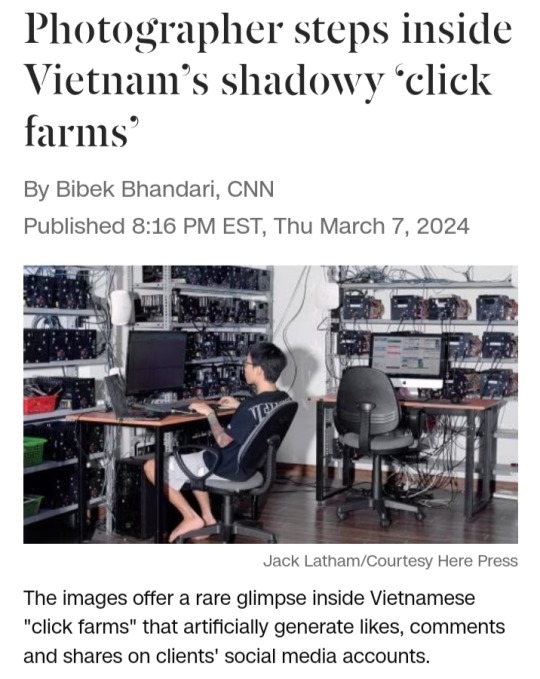
(CNN) — Jack Latham was on a mission to photograph farms in Vietnam — not the country’s sprawling plantations or rice terraces but its “click farms.”
Last year, the British photographer spent a month in the capital Hanoi documenting some of the shadowy enterprises that help clients artificially boost online traffic and social media engagement in the hope of manipulating algorithms and user perceptions.
The resulting images, which feature in his new book “Beggar’s Honey,” provide rare insight into the workshops that hire low-paid workers to cultivate likes, comments and shares for businesses and individuals globally.
“When most people are on social media, they want nothing but attention — they’re begging for it,” Latham said in a phone interview, explaining his book’s title.
“With social media, our attention is a product for advertisers and marketers.”

In the 2000s, the growing popularity of social media sites — including Facebook and Twitter, now called X — created a new market for well-curated digital profiles, with companies and brands vying to maximize visibility and influence.
Though it is unclear when click farms began proliferating, tech experts warned about “virtual gang masters” operating them from low-income countries as early as 2007.
In the following decades, click farms exploded in number — particularly in Asia, where they can be found across India, Bangladesh, Indonesia, the Philippines, and beyond.
Regulations have often failed to keep pace: While some countries, like China, have attempted to crack down on operations (the China Advertising Association banned the use of click farms for commercial gain in 2020), they continue to flourish around the continent, especially in places where low labor and electricity costs make it affordable to power hundreds of devices simultaneously.
‘Like Silicon Valley startups’
Latham’s project took him to five click farms in Vietnam.
(The click farmers he hoped to photograph in Hong Kong “got cold feet,” he said, and pandemic-related travel restrictions dashed his plans to document the practice in mainland China).
On the outskirts of Hanoi, Latham visited workshops operating from residential properties and hotels.
Some had a traditional setup with hundreds of manually operated phones, while others used a newer, compact method called “box farming” — a phrase used by the click farmers Latham visited — where several phones, without screens and batteries, are wired together and linked to a computer interface.

Latham said one of the click farms he visited was a family-run business, though the others appeared more like a tech companies.
Most workers were in their 20s and 30s, he added.
“They all looked like Silicon Valley startups,” he said. “There was a tremendous amount of hardware … whole walls of phones.”
Some of Latham’s photos depict — albeit anonymously — workers tasked with harvesting clicks.
In one image, a man is seen stationed amid a sea of gadgets in what appears to be a lonely and monotonous task.
“It only takes one person to control large amounts of phones,” Latham said. “One person can very quickly (do the work of) 10,000. It’s both solitary and crowded.”
At the farms Lathan visited, individuals were usually in charge of a particular social media platforms.
For instance, one “farmer” would be responsible for mass posting and commenting on Facebook accounts, or setting up YouTube platforms where they post and watch videos on loop.
The photographer added that TikTok is now the most popular platform at the click farms he visited.

The click farmers Latham spoke to mostly advertised their services online for less than one cent per click, view or interaction.
And despite the fraudulent nature of their tasks, they seemed to treat it like just another job, the photographer said.
‘There was an understanding they were just providing a service,” he added. “There wasn’t a shadiness. What they’re offering is shortcuts.”
Deceptive perception
Across its 134 pages, “Beggar’s Honey” includes a collection of abstract photographs — some seductive, others contemplative — depicting videos that appeared on Latham’s TikTok feed.
He included them in the book to represent the kind of content he saw being boosted by click farms.
But many of his photos focus on the hardware used to manipulate social media —webs of wires, phones and computers.
“A lot of my work is about conspiracies,” Latham said. ” Trying to ‘document the machines used to spread disinformation’ is the tagline of the project. The bigger picture is often the thing we don’t see.”

Click farms around the world are also used to amplify political messages and spread disinformation during elections.
In 2016, Cambodia’s then-prime minister Hun Sen was accused of buying Facebook friends and likes, which according to the BBC he denied, while shadowy operations in North Macedonia were found to have spread pro-Donald Trump posts and articles during that year’s US presidential election.
While researching, Latham said he found that algorithms — a topic of his previous book, “Latent Bloom” — often recommended videos that he said got increasingly “extreme” with each click.
“If you only digest a diet of that, it’s a matter of time you become diabetically conspiratorial,” he said.
“The spreading of disinformation is the worst thing. It happens in your pocket, not newspapers, and it’s terrifying that it’s tailored to your kind of neurosis.”
Hoping to raise awareness of the phenomenon and its dangers, Latham is planning to exhibit his own home version of a click farm — a small box with several phones attached to a computer interface — at the 2024 Images Vevey Festival in Switzerland.
He bought the gadget in Vietnam for the equivalent of about $1,000 and has occasionally experimented with it on his social media accounts.
On Instagram, Latham’s photos usually attract anywhere from a few dozen to couple hundred likes.
But when he deployed his personal click farm to announce his latest book, the post generated more than 6,600 likes.
The photographer wants people to realize that there’s more to what they see on social media — and that metrics aren’t a measurement of authenticity.
“When people are better equipped with knowledge of how things work, they can make more informed decisions,” he said.

“Beggar’s Honey,” co-published by Here Press and Images Vevey, is available now.
#Jack Latham#click farms#box farms#Hanoi#Vietnam#Beggar’s Honey#box farming#social media#algorithms#user perception#trolls#PR#marketing#advertising#likes#comments#shares#digital profiles#virtual gang masters#bots#spam#China Advertising Association#click farmers#mass post#disinformation#misinformation#fake news#metrics
13 notes
·
View notes
Text
Social media has become an integral part of business strategies, offering a direct channel to connect with the target audience. To harness the full potential of social platforms, businesses need more than just an online presence—they need actionable insights. That's where social media analytics comes into play.
#Social Media Analytics#Online Reputation Management India#India ORM Services#ORM Solutions India#Best ORM Company India#Online Brand Protection India#Reputation Repair India#India Reputation Monitoring#India Reputation Cleanup#Personal Brand Management India#Online Image Repair India#Corporate Reputation India#India ORM Strategies#ORM for Small Businesses India#India Reputation Crisis#Affordable ORM Services India#ORM Expert India#India Online Image Management#Local Business Reputation India#ORM for Startups India#India Reputation Building
0 notes
Text
Heart Care Centre In Gorakhpur
When it comes to maintaining overall health, few things are as vital as taking care of your heart. As the heart continues to be one of the most critical organs in our body, any issues related to it must be taken seriously. In Gorakhpur, the demand for quality heart care services has risen significantly, as people are becoming more aware of the importance of cardiovascular health. Fortunately, Gorakhpur is home to some of the best heart care centre, where patients can receive expert treatment and guidance on managing heart conditions.
In this blog, we’ll explore the best heart care centre in Gorakhpur, the services they offer, and why you should choose them for your heart health needs.

Heart diseases continue to be one of the leading causes of death worldwide. In India, the rise of lifestyle diseases such as hypertension, diabetes, and high cholesterol has contributed to an increase in heart-related problems. Early diagnosis and intervention are key to managing heart conditions effectively. This is where a good heart care centres comes into play. Heart care centres are equipped with advanced technology, skilled cardiologists, and modern facilities to provide accurate diagnosis, treatment, and preventive care for a wide range of heart diseases.
Services Offered at Heart Care Centres in Gorakhpur
Heart care centres in Gorakhpur provide a variety of services, ranging from preventive care to advanced treatment options. Here are some of the key services you can expect:
1. Cardiology Consultations
A heart care centre begins with consultations with experienced cardiologists who assess your symptoms, medical history, and risk factors. These consultations often involve a thorough examination and may be followed by diagnostic tests to understand the root cause of any heart issues.
2. Comprehensive Diagnostic Tests
Accurate diagnosis is the first step toward effective treatment. Heart care centres in Gorakhpur offer state-of-the-art diagnostic tools such as:
Electrocardiogram (ECG)
Echocardiogram (ultrasound of the heart)
Stress tests
Holter monitoring
Angiography and angioplasty
These tests help identify underlying conditions like heart disease, arrhythmias, blocked arteries, and more.
3. Cardiac Surgery and Interventions
For patients with severe heart conditions, heart care centres in Gorakhpur offer surgical interventions such as:
Coronary Artery Bypass Grafting (CABG)
Valve replacement or repair
Angioplasty and stent placement
These procedures are performed by expert cardiac surgeons who specialize in heart-related surgeries, ensuring the best outcomes for patients.
4. Preventive Care and Health Monitoring
Heart care centres emphasize preventive care to help individuals avoid heart disease. They provide services like:
Routine health check-ups
Blood pressure and cholesterol monitoring
Lifestyle counseling (diet, exercise, stress management)
Weight management and smoking cessation programs
By focusing on prevention, these centres help patients lower the risk of heart disease and maintain a healthy lifestyle.
5. Cardiac Rehabilitation
After a heart attack or surgery, patients require a rehabilitation program to recover fully. Cardiac rehabilitation involves supervised exercise, diet counseling, and psychological support to help individuals regain strength and reduce the risk of further complications.
Why Choose a Heart Care Centre in Gorakhpur?
1. Expert Cardiologists
Heart care centres in Gorakhpur are staffed by experienced and qualified cardiologists who specialize in diagnosing and treating a wide range of heart conditions. Whether you’re dealing with high blood pressure, irregular heartbeats, or more severe conditions like coronary artery disease, these professionals provide the best possible care.
2. State-of-the-Art Facilities
The heart care centres in Gorakhpur are equipped with the latest technology, including high-resolution imaging systems, advanced cardiac monitoring tools, and cutting-edge surgery equipment. This allows doctors to provide accurate diagnoses and offer effective treatment options for heart patients.
3. Personalized Care
Each patient is unique, and heart care centres understand the importance of providing personalized care. From the first consultation to post-treatment care, cardiologists work with patients to create tailored treatment plans that suit their individual needs and health goals.
4. Comprehensive Approach
These centres offer a comprehensive range of services under one roof, ensuring that all aspects of heart health are addressed. From diagnostic tests and treatment options to preventive care and rehabilitation, you can count on the heart care Centres in Gorakhpur to support your heart health journey.
Best Heart Care Centre in Gorakhpur.
Gupta Heart Care Centre in Gorakhpur
This Centre are well-known for their experienced team of cardiologists, use of advanced medical technology, and focus on patient well-being.
Conclusion
Taking care of your heart is an essential aspect of living a long and healthy life. If you're experiencing any symptoms of heart disease or if you simply want to ensure your heart health is in check, it’s time to consult a trusted heart care centres in Gorakhpur. With world-class doctors, top-notch facilities, and comprehensive treatment options, you can rest assured that your heart is in safe hands.
Remember, early detection and intervention can save lives. Don’t wait for symptoms to worsen—schedule a consultation at one of Gorakhpur’s leading heart care centres today.
Call to Action: If you or someone you know is concerned about their heart health, don't delay. Contact a reliable Heart Care Centre in Gorakhpur for an assessment and start your journey toward a healthier heart today
2 notes
·
View notes
Text
Common Web Design Mistakes and How to Avoid Them
Designing a website is a critical step in establishing a strong online presence. However, even the most well-intentioned efforts can result in mistakes that impact usability, performance, and SEO. In this article, we’ll highlight common web design mistakes and provide actionable solutions to avoid them. By addressing these pitfalls, you can ensure your website achieves its full potential and stands out in a competitive digital landscape.
1. Ignoring Mobile Responsiveness
The Mistake: Many websites still lack proper mobile optimization, leading to poor user experience on smartphones and tablets.
How to Avoid It: Prioritize responsive web design services to ensure your website adapts seamlessly to all devices. Partnering with a leading website development company in Jaipur can help you create a mobile-friendly website.
2. Overloading with Visual Elements
The Mistake: Using excessive images, animations, or design elements can slow down your site and confuse users.
How to Avoid It: Focus on simplicity and functionality. Balance visuals with clean layouts that enhance user navigation without sacrificing speed.
3. Poor Navigation Structure
The Mistake: Complicated menus or lack of a clear navigation path frustrates users and increases bounce rates.
How to Avoid It: Use intuitive navigation menus and ensure every page is easily accessible. Collaborate with web design experts who specialize in creating user-friendly interfaces.
4. Neglecting SEO Basics
The Mistake: Forgetting to optimize meta tags, headers, and images for search engines can harm your website’s visibility.
How to Avoid It: Work with SEO-savvy web developers who ensure your website is optimized for keywords like “best website development company in Jaipur” and “web design services.”
5. Slow Loading Speeds
The Mistake: Websites that take too long to load risk losing visitors before they even see the content.
How to Avoid It: Use tools to compress images, minimize CSS/JavaScript, and optimize your hosting. Regular performance checks by professional developers are essential.
6. Inconsistent Design Elements
The Mistake: Mismatched fonts, colors, and layouts create a lack of brand identity and professionalism.
How to Avoid It: Maintain a consistent design theme throughout your website. Utilize brand colors and typography to enhance recognition and trust.
7. Failing to Include a Call-to-Action (CTA)
The Mistake: A lack of clear CTAs results in missed opportunities to convert visitors into customers.
How to Avoid It: Add compelling CTAs on every key page, guiding users toward desired actions like signing up or making a purchase.
8. Ignoring Accessibility
The Mistake: Not designing for accessibility excludes a significant portion of users with disabilities.
How to Avoid It: Implement features like alt text for images, keyboard navigation, and proper contrast ratios.
Reach Out to the Best Website Development Company in Jaipur — Webpino Software
Webpino Software is a leading web development and digital marketing company in India. Our expert team specializes in creating cutting-edge websites, intuitive mobile apps, tailored SEO strategies, and responsive web design services to meet your unique business needs. With over a decade of experience and a proven track record of successfully delivering innovative solutions, we are dedicated to helping your business thrive online.
If you’re ready to bring your digital vision to life, let the best website development company in Jaipur, Webpino Software, transform your ideas into reality. Contact us today to explore how we can elevate your online presence!
#website development#web design#wordpress development#website design#web developers#digital marketing#seo#website#seo friendlly website#business website solutions#custom website design#website optimization#web hosting#wordpress#website design in jaipur#best website development company in jaipur
2 notes
·
View notes
Text
Let Acoustics Rule Your World!

Are you ready to lose yourself in the power of amplified, acoustically treated sound?
Elevate your entertainment experience with our Acoustic Home Theatres, now available across India's key cities—Delhi, Mumbai, Bengaluru, Hyderabad, and more! Whether it’s the captivating Sound of Music, the thrill of Gaming, the excitement of Sports, or the drama of your favorite TV Shows, superior sound is the gateway to an unforgettable experience.
We promise to take you to new heights with our highly acoustically treated Home Theatres. From the pulse of a DJ concert to the ambience of a serene jungle, each Installation is meticulously designed!
Your taste, our creation!
We specialize in transforming your dreams into reality, offering:
Hi-Fi AV systems
Advanced home automation
Custom recliners
Expert acoustic treatments
Elegant theatre interiors
Let us redefine your living space into an immersive entertainment hub where every sound, image, and detail leaves an everlasting impression. Thanks to near-3D visuals and immersive surround sound, every dialogue and note will captivate you.
Transform your environment with our Acoustic Home Theatres—because we understand your world like no one else.
Discover the difference. Lose yourself in superior acoustics today!
#Acoustic home theatre system#Acoustic material for home theatre#Home theatre acoustic design#Home theatre acoustic wall panels#Home theatre acoustic work#Acoustic paneling#Acoustic insulation for home theatre#Acoustic curtains for home theatre#Acoustic wall panel for home cinema#Acoustic panel home theatre#Acoustic Tv wall#Acoustic panel for Home theatre in India#Acoustic for home theatre India#Acoustic sound deadening panels#Acoustical foam#Acoustic board#Acoustical door
2 notes
·
View notes
Text
Hair Transplant: Everything You Need to Know About Restoring Hair Confidence
Hair loss is a common concern affecting millions of people worldwide. While it can have a significant impact on one’s confidence and self-image, advances in medical science have provided a revolutionary solution: hair transplants. If you’re dealing with hair loss or thinning and considering treatment options, Delhi has emerged as a leading destination for world-class hair restoration services. From cutting-edge techniques like FUE hair transplant technique in Delhi to specialized services such as eyebrow transplant in India, this article covers everything you need to know.
What is a Hair Transplant?
A hair transplant is a surgical procedure designed to restore hair in areas of thinning or baldness. It involves relocating hair follicles from a donor site, typically the back or sides of the scalp, to the recipient area. The result is a fuller, more natural-looking hairline or improved density. Over the years, hair transplant procedures have become safer, more effective, and virtually undetectable, thanks to advanced techniques like Follicular Unit Extraction (FUE).
Why Delhi is a Hub for Hair Transplants
Delhi is home to some of the best hair restoration clinics in India, equipped with state-of-the-art facilities and experienced surgeons. Many of these clinics cater to both Indian and international patients, offering a wide range of services tailored to individual needs. The combination of expertise, affordability, and cutting-edge technology makes a hair clinic in Delhi an ideal choice for those seeking transformative results.
Key Features of Hair Clinics in Delhi:
Expert Surgeons: Specialists with years of experience and internationally recognized certifications.
Modern Facilities: Equipped with advanced tools and sterile environments for safe procedures.
Personalized Treatment Plans: Tailored solutions based on the patient’s hair type, condition, and goals.
Affordable Pricing: Competitive costs compared to international standards, without compromising quality.
The FUE Hair Transplant Technique in Delhi
The FUE hair transplant technique in Delhi is a minimally invasive and highly effective method of hair restoration. Unlike older methods such as Follicular Unit Transplantation (FUT), FUE does not involve cutting a strip of skin from the scalp. Instead, it extracts individual hair follicles directly from the donor area using specialized equipment.
Benefits of FUE Hair Transplant:
Natural Appearance: Provides natural-looking results with precise placement of hair follicles.
No Linear Scarring: Leaves tiny, dot-like scars that are virtually invisible.
Quick Recovery: Patients can return to normal activities within a few days.
Versatile Applications: Suitable for restoring hair on the scalp, beard, or even eyebrows.
Eyebrow Transplant in India: A Growing Trend
Eyebrows play a vital role in framing the face and enhancing facial expressions. For individuals with sparse, uneven, or over-plucked eyebrows, an eyebrow transplant in India offers a permanent solution. This specialized procedure uses the FUE technique to implant individual hair follicles into the brow area, creating fuller, symmetrical, and natural-looking eyebrows.
Who Can Benefit From an Eyebrow Transplant?
Individuals with Sparse Brows: Caused by genetics, aging, or hormonal changes.
Over-Pluckers: Those who have excessively tweezed their eyebrows over time.
Medical Conditions: Patients with conditions like alopecia or scarring that affect eyebrow growth.
Cosmetic Enhancement Seekers: Individuals looking for perfectly shaped, fuller eyebrows.
Steps to a Successful Hair Transplant
Choosing the right clinic and preparing adequately for your procedure is crucial to achieving the best results. Here are some key steps:
1. Research Clinics Thoroughly
Look for a reputable hair clinic in Delhi with experienced surgeons, positive patient reviews, and modern facilities.
2. Schedule a Consultation
A detailed consultation helps the doctor assess your hair loss pattern, discuss your goals, and suggest the most suitable treatment plan.
3. Understand the Procedure
Whether you’re opting for a scalp transplant or an eyebrow transplant in India, understanding the procedure, recovery time, and expected outcomes is essential.
4. Post-Operative Care
Follow the surgeon’s advice on caring for the transplanted area, avoiding strenuous activities, and maintaining scalp hygiene for optimal results.
Why Hair Transplants Are Life-Changing
Hair transplants are not just about aesthetics; they are about restoring confidence. Whether you choose the FUE hair transplant technique in Delhi for your scalp or opt for an eyebrow transplant in India, the benefits extend beyond physical appearance. A successful hair transplant can:
Boost self-esteem and confidence.
Provide a permanent solution to hair loss.
Enhance overall facial harmony.
Help individuals feel more comfortable in social and professional settings.
Final Thoughts
Hair transplants have come a long way, offering natural and permanent solutions for hair loss. With its advanced technology, skilled professionals, and affordable treatment options, Delhi has become a leading destination for hair restoration procedures. If you’re ready to transform your look, consult a trusted hair clinic in Delhi to explore the best options, including the FUE hair transplant technique in Delhi and specialized procedures like eyebrow transplant in India. Reclaim your confidence and let your hair tell a story of transformation and renewal!
2 notes
·
View notes
Text
10 Key Strategies for Successful Foreign Investment in India by 2025

India, with its rapidly expanding economy and growing consumer base, offers compelling opportunities for foreign investors. However, capitalizing on these opportunities requires a nuanced understanding of the market and a strategic approach. As we look towards 2025, here are ten essential strategies for foreign investors aiming to achieve success in India’s dynamic landscape.
1. Mastering Local Regulations and Compliance
Understanding and navigating India's regulatory environment is crucial for successful foreign investment. India has undergone significant regulatory reforms in recent years, but its complex legal framework can still pose challenges.
Foreign Direct Investment (FDI) Policies
The Indian government has made strides in simplifying FDI regulations. However, sectors such as defense, retail, and telecommunications have specific guidelines that investors must adhere to. Familiarize yourself with the latest regulations through resources such as the Department for Promotion of Industry and Internal Trade (DPIIT) and the Reserve Bank of India (RBI).
Local Partnerships
Given the complexity of local regulations, partnering with experienced legal and financial advisors can facilitate smoother operations. These local experts can help navigate bureaucratic processes, interpret regulations accurately, and ensure compliance with local laws.
2. Investing in Market Research and Data Analysis
Successful investments are often driven by comprehensive market research. Understanding the intricacies of consumer behavior and market trends is essential for tailoring your strategies.
Consumer Insights
India’s diverse demographic landscape requires detailed consumer insights. Utilize data analytics tools and market research firms to gather information on consumer preferences, spending habits, and emerging trends. This data will inform product development, marketing strategies, and pricing models.
Sector-Specific Analysis
Different sectors in India exhibit unique characteristics and challenges. For instance, the technology sector may face different regulatory and competitive dynamics compared to the retail or manufacturing sectors. Conduct in-depth sector analysis to identify opportunities and mitigate risks.
3. Building a Robust Local Network
Establishing strong local connections is a cornerstone of successful foregin investment in India. Networking with local businesses, government officials, and industry leaders can open doors to valuable opportunities.
Strategic Partnerships
Form alliances with local businesses and industry bodies to gain market entry and credibility. These partnerships can offer valuable insights, facilitate regulatory compliance, and provide access to established distribution channels.
Engage Local Expertise
Consult with local experts who understand the regional business environment. They can offer guidance on navigating local customs, market conditions, and business practices, which can be critical for making informed decisions.
4. Adapting to India’s Cultural and Regional Diversity
India’s cultural and regional diversity means that a one-size-fits-all approach is often ineffective. Tailoring your strategies to local preferences and cultural nuances can enhance market acceptance and brand loyalty.
Cultural Sensitivity
Understanding and respecting local customs and traditions is crucial for building a positive brand image. Adapt your marketing messages, product offerings, and business practices to align with regional cultures and values.
Regional Variations
India’s states and regions vary significantly in terms of economic development, consumer behavior, and regulatory environments. Develop region-specific strategies to address these differences and optimize your market approach.
5. Leveraging Technology and Innovation
India’s technology landscape is rapidly evolving, with significant growth in digital infrastructure and innovation. Embracing technology can enhance operational efficiency and market reach.
Digital Infrastructure
Invest in digital platforms and technologies to connect with India’s tech-savvy consumers. Utilize digital marketing, e-commerce platforms, and data analytics to drive growth and engage with your target audience.
Innovation
India’s startup ecosystem is vibrant and innovative. Consider collaborating with local startups or technology providers to incorporate cutting-edge solutions and stay ahead of market trends.
6. Embracing Sustainability and Corporate Social Responsibility (CSR)
Sustainability and CSR are increasingly important in India’s business environment. Adopting sustainable practices and engaging in CSR initiatives can enhance your brand’s reputation and contribute to long-term success.
Environmental Responsibility
Implement sustainable practices in your operations, such as reducing waste, conserving energy, and minimizing your carbon footprint. Compliance with environmental regulations and voluntary sustainability standards can also improve your business’s credibility.
CSR Initiatives
Engage in CSR activities that address local community needs and align with your company’s values. Contributing to education, healthcare, and social development projects can build goodwill and strengthen your brand’s presence in the community.
7. Monitoring Economic and Political Developments
India’s economic and political landscape can significantly impact investment outcomes. Staying informed about macroeconomic trends and policy changes is crucial for adapting your strategies and mitigating risks.
Policy Changes
Keep abreast of changes in government policies and economic reforms. Policy shifts, such as changes in tax regulations or trade policies, can affect your investment strategy and operational plans.
Economic Trends
Monitor key economic indicators, including inflation rates, currency fluctuations, and growth forecasts. Understanding these trends will help you anticipate market shifts and make informed investment decisions.
8. Optimizing Supply Chain and Logistics
Efficient supply chain and logistics management are vital for operating effectively in India’s diverse and sometimes challenging infrastructure environment.
Logistics Infrastructure
India’s logistics sector is evolving, but challenges such as transportation bottlenecks and infrastructure gaps remain. Develop a robust logistics strategy that includes reliable partners and technology solutions to streamline operations.
Local Sourcing
Consider local sourcing options to reduce supply chain costs and improve efficiency. Building relationships with local suppliers and manufacturers can also mitigate risks associated with international logistics.
9. Focusing on Talent Acquisition and Management
India’s growing talent pool presents opportunities for building a skilled workforce. Attracting, retaining, and developing talent is essential for long-term success.
Local Talent
Invest in hiring local talent who understand the Indian market and can contribute valuable insights and skills. Implement training programs to enhance their capabilities and align them with your company’s goals.
Retention Strategies
Create a positive work environment and offer competitive compensation packages to retain top talent. Focus on career development, work-life balance, and employee engagement to foster loyalty and reduce turnover.
10. Embracing Flexibility and Adaptability
The Indian market is dynamic and constantly evolving. Being flexible and adaptable will enable you to respond to changes and seize new opportunities.
Market Dynamics
Be prepared to adjust your strategies in response to market shifts, consumer preferences, and competitive pressures. Regularly review and refine your approach to stay relevant and competitive.
Feedback Mechanisms
Establish systems for gathering and acting on feedback from customers, partners, and stakeholders. Continuous improvement based on real-time insights will help you stay aligned with market demands and enhance your business performance.
Investing in India offers significant potential, but success requires a strategic approach that addresses the complexities of the market.
Fox&Angel, a leading Global Expansion Partner with a focus on facilitating foreign direct investment (FDI) in India can help you. Our expert team is well-versed in the complexities of the Indian market, offering comprehensive support to ensure your investment is both strategic and successful. Whether you’re aiming to expand your current operations, explore new market opportunities, or make a direct investment, Fox&Angel provides the insight and resources needed to navigate this dynamic landscape.
Our deep understanding of the Indian economic environment allows us to identify and leverage the most promising opportunities for growth. We guide you through every step of the investment process, from initial market analysis to regulatory compliance, ensuring a seamless entry and operational experience.
With Fox&Angel’s support, you gain a trusted partner dedicated to helping you achieve your business goals in India and successfully invest in India. Our tailored strategies and local expertise empower you to confidently make informed decisions and drive success in one of the world’s most vibrant markets.
This post was originally published on: Foxnangel
#fdi in india#fdi investment in india#foreign investment in india#startups in india#franchise in india#regulatory compliance#invest in inda#foxnangel
2 notes
·
View notes